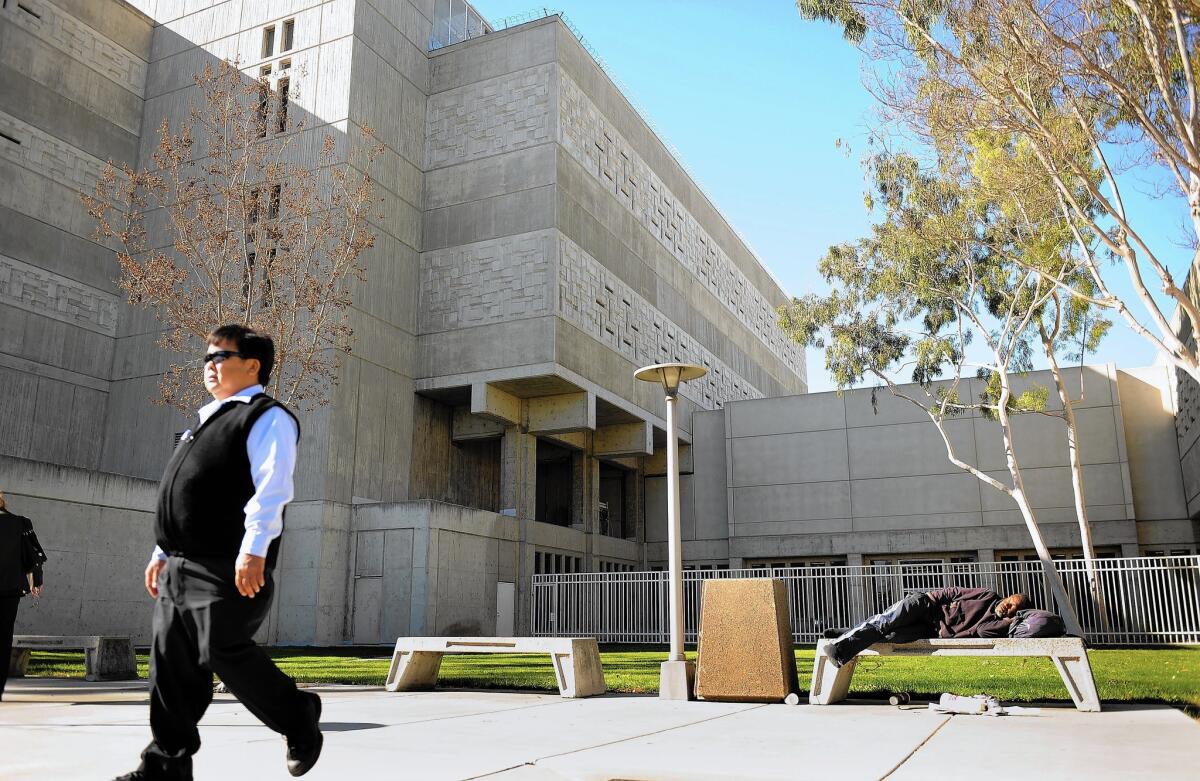As manhunt for 3 inmates continues, experts dissect why it took the O.C. jail so long to detect the escape

Phuong Nguyen, an Orange County Sheriff’s deputy, speaks to the media in Vietnamese at a news conference in Santa Ana.
- Share via
The escape from Orange County’s largest jail probably took only a few minutes.
But it took 16 hours for jailers to realize that three dangerous inmates had broken out of the Santa Ana lockup. This gap gave the men a huge head start on their pursuers, who on Monday continued a sweeping but unsuccessful dragnet.
The length of time it took for authorities at the Men’s Central Jail in Santa Ana to detect the escape was one of several issues detention experts and others were dissecting Monday amid the manhunt. Some also questioned why inmates accused of violent crimes were housed in dormitories rather than individual cells, which is the practice at other jails and prisons in the state.
The last time jail personnel saw Hossein Nayeri, Jonathan Tieu or Bac Duong was during a 5 a.m. Friday prisoner count. Orange County jail staff only conduct two physical inspections of inmates each day. The second check Friday was delayed until 9 p.m. by a jailhouse brawl that some investigators believe was designed to cover the initial escape, officials said.
Nayeri, 37, was charged in the 2012 torture and kidnapping of a wealthy marijuana dispensary owner and his housemate’s girlfriend. Nayeri and several accomplices allegedly dragged the man into a desert, burned him with a blowtorch, doused him with bleach and severed his penis, authorities have said. They believed he was hiding up to $1 million in cash and hoped the torture would cause him to surrender the money. The victim was left to die in the desert but was rescued after the woman with whom he was kidnapped ran nearly a mile to get help.
Tieu, 20, was described as a “documented Vietnamese gang member” awaiting a retrial in connection with a 2011 gangland murder, prosecutors said.
Duong, 43, has several prior convictions and had been charged with attempted murder in a 2015 shooting in Santa Ana.
The three were also formally charged with escape Monday, prosecutors said.
The men were held in a section of the Santa Ana jail known as Module F, a fourth-floor dormitory where 68 inmates sleep in bunk beds rather than individual cells. To escape, Nayeri, Tieu and Duong had to cut through at least four layers of metal, steel and rebar in the dormitory, go through unsecured plumbing tunnels and make their way to the roof, where they used a makeshift rope of knotted bedsheets and cloth to rappel to freedom, said Lt. Jeffrey Hallock, a spokesman for the Orange County Sheriff’s Department.
“These guys have nothing to lose. These guys were looking at life terms,” said Martin Horn, a former head of corrections in New York City and Pennsylvania who now teaches at the John Jay College of Criminal Justice in New York City. “Why are they, looking at life or worse, not being held in closed cells? Who made that judgment?”
Merrick Bobb, who once oversaw reforms of the Los Angeles County jail system, said it seems unlikely that the men obtained the materials necessary to create their escape route on their own, and he said he was surprised to hear that what was tantamount to a weeks-long construction project went undetected.
“These aren’t tools that can be made out of dental floss,” Bobb said. “Such cutting creates a lot of noise, and it would have to be covered up.”
No jail employee has been suspended as part of the investigation into the breakout, and officials said they have not found any evidence that jail personnel played a role in the escape.
In contrast to Orange County, the Los Angeles County Sheriff’s Department houses inmates accused of murder or attempted murder, such as Tieu and Duong, or inmates with violent criminal pasts, such as Nayeri, in individual cells, said Cmdr. Keith Swensson, a department spokesman.
At the state level, inmates convicted of violent crimes are also normally held in individual cells. An inmate convicted of murder could, with a lengthy stretch of good behavior, be promoted from maximum-security housing to a less-secure dormitory setup, but that could take as long as 20 years, said Terry Thornton, a spokeswoman for the California Department of Corrections and Rehabilitation.
Orange County also conducts physical counts of its inmates less frequently than jailers in Los Angeles County and those at the state level. In Los Angeles, deputies conduct physical checks on inmates at the downtown Men’s Central Jail at least three times a day, Swensson said. State corrections officials are required by state regulations to do so a minimum of four times a day.
Since its construction in 1968, the Santa Ana jail facility has seen only three escapes, the last of which came in 1989, Hallock said. But that success rate could have been part of the problem.
“Complacency is the No. 1 enemy of good jail administration. No one has escaped in years, so why worry?” Horn said. “Officers and deputies tend to believe nothing happens, so they let down their guard. When I was in Pennsylvania, we had three escapes, and complacency was to blame for them all.”
During a Monday news briefing, Orange County sheriff’s officials were repeatedly asked about the decision to house the three men in dorms and the time gap between the jailhouse counts.
“The focus right now is on apprehending the suspects; at some point we will be looking at our protocols,” said Orange County Sheriff’s Lt. Dave Sawyer, who is leading the investigation.
Sawyer said that investigators do not believe the three men have fled the state or country. Based on Tieu and Duong’s gang connections, Sawyer said it is more likely that the men “may be embedded somewhere in the community.” Police made pleas to the local Vietnamese community in both English and Vietnamese, asking for help in capturing the escapees.
“We sincerely need input from the community to help us put these three dangerous individuals back into custody,” Sawyer said.
A spokeswoman for the Sheriff’s Department said Sunday that the men would not have been housed in the dorm-style area if they were known to be flight risks. It is unclear what information jailers had when they assigned the escapees to their living quarters.
Although it does not appear Nayeri had been accused in a previous prison break, he has twice fled the country to escape criminal charges. After the alleged attack on the marijuana dispensary owner, Nayeri fled to Iran and remained there for several months before he was arrested in Prague, Czech Republic, according to Orange County authorities.

The scene outside the Central Men’s Jail in Santa Ana.
In 2005, after he’d been arrested in connection with a drunk-driving death in Madera County, Nayeri also fled the country after posting bond, said Roger Bonakdar, an attorney representing relatives of the victim, Ehsan Tousi. He was arrested again in 2006 and sentenced to one year in prison under a plea agreement, Bonakdar said.
Several calls to the Madera County district attorney’s office seeking information about the case were not returned.
The Orange County case has drawn national attention after a similar escape at a maximum security prison in upstate New York last summer. Convicted killers Richard Matt and David Sweat sparked a three-week manhunt after they used power tools to cut through steel pipes and plates inside the aging Clinton Correctional Facility in Dannemora, N.Y., to break through a brick wall and climb out through a manhole cover on their way out of the prison.
The escape also raised questions about the possibility that the men had received help and sparked criticism about the freedom the men were given despite their murder convictions. The two were granted more freedom than most inmates because they were members of an “honor” program. An investigation later revealed that a prison employee provided them with some of the tools necessary for their escape.
Matt was shot and killed 20 days after he escaped, and Sweat was shot and captured two days after that.
Escapes from state prisons have declined greatly in California in recent decades, records show. Some experts said the Orange County breakout highlights the issue of holding inmates awaiting trial for violent crimes in jails, rather than prisons, which are designed to contain inmates for lengthy stretches of time.
“If you give them enough time,” Bobb said, “they will learn your systems.”
Times staff writers Christopher Goffard and Anh Do contributed to this report.
See more of our top stories on Facebook >>
MORE ON THE PRISON ESCAPE
Escaped inmates charged with new felonies as Orange County manhunt widens
O.C. jail escape: As search for inmates intensifies, Little Saigon is left on edge
Photos: Three escaped inmates from Orange County jail remain on the run
More to Read
Get the Latinx Files newsletter
Stories that capture the multitudes within the American Latinx community.
You may occasionally receive promotional content from the Los Angeles Times.








